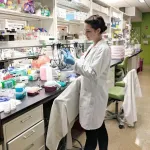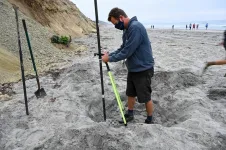(Press-News.org) Imaging techniques enable a detailed look inside an organism. But interpreting the data is time-consuming and requires a great deal of experience. Artificial neural networks open up new possibilities: They require just seconds to interpret whole-body scans of mice and to segment and depict the organs in colors, instead of in various shades of gray. This facilitates the analysis considerably.
How big is the liver? Does it change if medication is taken? Is the kidney inflamed? Is there a tumor in the brain and did metastases already develop? In order to answer such questions, bioscientists and doctors to date had to screen and interpret a wealth of data.
"The analysis of three-dimensional imaging processes is very complicated," explains Oliver Schoppe. Together with an interdisciplinary research team, the TUM researcher has now developed self-learning algorithms to in future help analyze bioscientific image data.
At the core of the AIMOS software - the abbreviation stands for AI-based Mouse Organ Segmentation - are artificial neural networks that, like the human brain, are capable of learning. "You used to have to tell computer programs exactly what you wanted them to do," says Schoppe. "Neural networks don't need such instructions:" It's sufficient to train them by presenting a problem and a solution multiple times. Gradually, the algorithms start to recognize the relevant patterns and are able to find the right solutions themselves."
Training self-learning algorithms
In the AIMOS project, the algorithms were trained with the help of images of mice. The objective was to assign the image points from the 3D whole-body scan to specific organs, such as stomach, kidneys, liver, spleen, or brain. Based on this assignment, the program can then show the exact position and shape.
"We were lucky enough to have access to several hundred image of mice from a different research project, all of which had already been interpreted by two biologists," recalls Schoppe. The team also had access to fluorescence microscopic 3D scans from the Institute for Tissue Engineering and Regenerative Medicine at the Helmholtz Zentrum München.
Through a special technique, the researchers were able to completely remove the dye from mice that were already deceased. The transparent bodies could be imaged with a microscope step by step and layer for layer. The distances between the measuring points were only six micrometers - which is equivalent to the size of a cell. Biologists had also localized the organs in these datasets.
Artificial intelligence improves accuracy
At the TranslaTUM the information techs presented the data to their new algorithms. And these learned faster than expected, Schoppe reports: "We only needed around ten whole-body scans before the software was able to successfully analyze the image data on its own - and within a matter of seconds. It takes a human hours to do this."
The team then checked the reliability of the artificial intelligence with the help of 200 further whole-body scans of mice. "The result shows that self-learning algorithms are not only faster at analyzing biological image data than humans, but also more accurate," sums up Professor Bjoern Menze, head of the Image-Based Biomedical Modeling group at TranslaTUM at the Technical University of Munich.
The intelligent software is to be used in the future in particular in basic research: "Images of mice are vital for, for example, investigating the effects of new medication before they are given to humans. Using self-learning algorithms to analyze image data in the future will save a lot of time in the future," emphasizes Menze.
INFORMATION:
The research was conducted at TranslaTUM, the Center for Translational Cancer Research, at the Technical University of Munich. The institute is part of the TUM University Hospital rechts der Isar and specializes in transferring cancer research insights to practical patient services through interdisciplinary cooperation. When using the novel 3D microscopy, the scientists at the TUM worked closely with experts at the Helmholtz Zentrum München.
The research project was funded by the German Federal Ministry of Education and Research (BMBF) within the scope of the Software Campus Initiative, the Deutsche Forschungsgemeinschaft (DFG) via the cluster of excellence Munich Cluster for Systems Neurology (SyNergy), as well as a research grant and by the TUM Institute for Advanced Study funded by the German excellence initiative and the European Union. The research was also funded by the Fritz Thyssen Foundation. NVIDIA supported the work of the GPU Grant Program.
Publication:
Oliver Schoppe, Chenchen Pan, Javier Coronel, Hongcheng Mai, Zhouyi Rong, Mihail Ivilinov Todorov, Annemarie Müskes, Fernando Navarro, Hongwei Li, Ali Ertürk, Bjoern H. Menze
Deep learning-enabled multi-organ segmentation in whole-body mouse scans
nature communications, 6.11.2020 - DOI: 10.1038/s41467-020-19449-7
December 28, 2020 - Platelet-rich plasma (PRP) treatment, which involves injecting a small amount of a patient's own blood to release various growth factors from platelets, continues to increase in popularity. The American Society of Plastic Surgeons has tracked the procedure since 2015 and reports a 25 percent increase in cosmetic PRP use in the last four years.
That increase in popularity could in part trace back to celebrities extolling the procedure's cosmetic benefits. Yet with so much information coming from so many different sources about the treatment's ...
Cells, the basic unit of life, are surrounded by a limiting membrane called the plasma membrane. Inside cells, there are various membrane-bounded organelles, each of which has various and distinctive functions. How these organelles, which individually boast different functions, have been developed during evolution remains unknown. This phenomenon has fascinated many researchers.
In the study published in Nature Communications, the evolutionary relationship between two different organelles in liverwort cells has been revealed: the cell plate, which divides ...
Two new studies from the University of Rochester Medical Center (URMC) have uncovered an association between vaping and mental fog. Both adults and kids who vape were more likely to report difficulty concentrating, remembering, or making decisions than their non-vaping, non-smoking peers. It also appeared that kids were more likely to experience mental fog if they started vaping before the age of 14.
While other studies have found an association between vaping and mental impairment in animals, the URMC team is the first ...
Researchers from Yokohama National University in Japan have developed a prototype microprocessor using superconductor devices that are about 80 times more energy efficient than the state-of-the-art semiconductor devices found in the microprocessors of today's high-performance computing systems.
As today's technologies become more and more integrated in our daily lives, the need for more computational power is ever increasing. Because of this increase, the energy use of that increasing computational power is growing immensely. For example, so much energy is used by modern day data centers that some are built near rivers so that the flowing water ...
COLUMBUS, Ohio - A single positive experience on a psychedelic drug may help reduce stress, depression and anxiety symptoms in Black, Indigenous and people of color whose encounters with racism have had lasting harm, a new study suggests.
The participants in the retrospective study reported that their trauma-related symptoms linked to racist acts were lowered in the 30 days after an experience with either psilocybin (Magic Mushrooms), LSD or MDMA (Ecstasy).
"Their experience with psychedelic drugs was so powerful that they could recall and report on changes in symptoms from racial trauma that they had experienced in their lives, and they ...
Cancer cells are known for spreading genetic chaos. As cancer cells divide, DNA segments and even whole chromosomes can be duplicated, mutated, or lost altogether. This is called chromosomal instability, and scientists at Memorial Sloan Kettering have learned that it is associated with cancer's aggressiveness. The more unstable chromosomes are, the more likely that bits of DNA from these chromosomes will end up where they don't belong: outside of a cell's central nucleus and floating in the cytoplasm.
Cells interpret these rogue bits of DNA as evidence ...
BOSTON - Some police departments in the United States continue to teach officers that neck restraints are a safe method for controlling agitated or aggressive people, but that's a dangerous myth, according to a Viewpoint written by three neurologists at Massachusetts General Hospital (MGH) in JAMA Neurology.
The killing of George Floyd, a Black man who died while being arrested in May 2020 after a police officer pressed a knee to his neck for more than eight minutes, helped spark a national conversation about racial ...
Certain bacteria, known as plant-growth-promoting bacteria (PGPB), can improve plant health or protect them from pathogens and are used commercially to help crops. To further improve agricultural yields, it is helpful to identify factors that can improve PGPB behavior.
Many PGPB form sticky communities of cells, known as biofilms, that help them adhere to plant roots. A group of scientists in North Carolina and Massachusetts were interested in finding other plant-associated bacteria that could help PGPB better adhere to plant roots, with the hope that increasing the number of PGPB cells attached to roots would increase their beneficial activities. ...
Scripps Institution of Oceanography at UC San Diego researchers have uncovered how rain and waves act on different parts of coastal cliffs.
Following three years of cliff surveys in and near the coastal city of Del Mar, Calif., they determined that wave impacts directly affect the base, and rain mostly impacts the upper region of the cliffs.
The study appears in the journal Geomorphology and was funded by California State Parks. California's State Parks Oceanography program supports climate adaptation and resilience efforts through coastal and cliff erosion observations and modeling, ...
Below please find a summary and link(s) of new coronavirus-related content published today in Annals of Internal Medicine. The summary below is not intended to substitute for the full article as a source of information. A collection of coronavirus-related content is free to the public at http://go.annals.org/coronavirus.
1. Review concludes universal mask use by lay persons reduces the spread of viral infections including SARS-CoV-2
Findings affirm policy promised by President-Elect Biden, who will ...



